Click on images to enlarge

habit in flower (Photo: Sheldon Navie)

habit in fruit with reddish-coloured stems (Photo: Mellisa Offord)
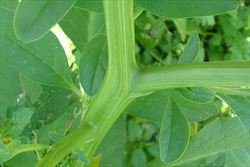
close-up of angled, hairless stems (Photo: Sheldon Navie)
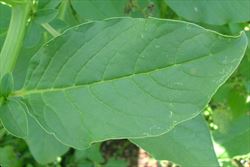
close-up of leaf (Photo: Sheldon Navie)
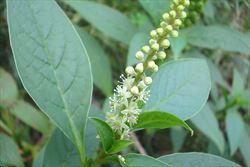
young flower cluster with flowers and flower buds (Photo: Sheldon Navie)

close-up of whitish flowers on very short stalks (Photo: Sheldon Navie)

elongated cluster of older flowers (Photo: Sheldon Navie)
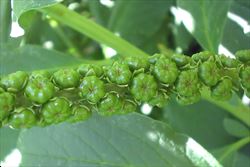
close-up of pumpkin-shaped young fruit (Photo: Sheldon Navie)

mature fruit releasing shiny black seeds (Photo: Sheldon Navie)
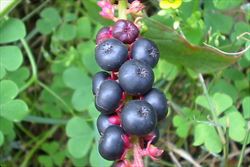
close-up of purplish-black mature fruit (Photo: Sheldon Navie)
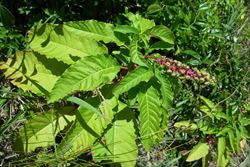
the very similar American pokeweed (Phytolacca americana) with immature fruit (Photo: Chris Gardiner)
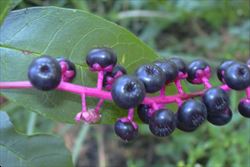
close-up of the mature fruit of American pokeweed (Phytolacca americana), which are borne on relatively long stalks (Photo: Forest and Kim Starr, USGS)
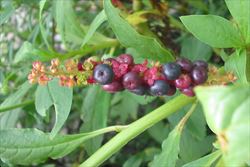
immature fruit and persistent 'petals' which are turning red in colour (Photo: Sheldon Navie)
Scientific Name
Phytolacca octandra L.
Synonyms
Phytolacca icosandra L.
Family
Phytolaccaceae
Common Names
dye-berry, dyeberry, eightstamen pokeweed, forest inkberry, ink weed, inkberry, inkweed, phytolacca, poke weed, pokeweed, red ink plant, red inkplant, red ink-weed, red-ink weed, scorpion tail, southern pokeberry, tropical pokeweed
Origin
Native to Mexico, Central America (i.e. Belize, Costa Rica, El Salvador, Guatemala, Honduras, Nicaragua and Panama), the Caribbean and tropical South America (i.e. Venezuela, Bolivia, Colombia, Ecuador and Peru).
Naturalised Distribution
Widely naturalised in southern and eastern Australia (i.e. in eastern Queensland, in many parts of New South Wales and Victoria, in south-eastern South Australia and in the coastal districts of south-western Western Australia). Also naturalised on Norfolk Island and possibly naturalised in the Northern Territory.
Naturalised overseas, including in New Zealand and on some Pacific islands (e.g. New Caledonia and Hawaii).
Habitat
A weed of disturbed sites, waste areas, roadsides, crops, gardens, pastures, forest margins, open woodlands and creek banks in tropical, sub-tropical and warmer temperate regions.
Habit
A short-lived herbaceous plant or small shrub growing up to 3 m tall.
Distinguishing Features
- a large herbaceous plant or small shrub growing to 3 m, but usually around 1 m tall.
- its branched stems and reddish and hairless.
- its alternately arranged leaves are green at first, but often trun reddish with age.
- its inconspicuous greenish-white flowers are almost stalkless and borne in elongated clusters (10-15 cm long).
- its purplish-black berries (4-8 mm across) contain a reddish-coloured juice.
Stems and Leaves
The upright (i.e. erect) branched stems are hairless (i.e. glabrous) and often reddish in colour. Younger stems may be greenish or pinkish in appearance, while older stems can become slightly woody towards the base of the plant.
The alternately arranged leaves are hairless (i.e. glabrous) and borne on stalks (i.e. petioles) 0.5-4 cm long. They are oval (i.e. elliptic), egg-shaped in outline (i.e. ovate) or elongated (i.e. lanceolate) in shape with pointed tips (i.e. acute apices) and entire margins. These leaves (3.5-22 cm long and 1-8 cm wide) are green at first, but often turn a reddish colour as they age.
Flowers and Fruit
The small flowers are white or greenish-white in colour and borne on short stalks (i.e. pedicels) 0.5-3 mm long. They are densely arranged in elongated clusters (i.e. spike-like racemes) 10-15 cm long. These clusters are borne on stalks (i.e. peduncles) 1-2 cm long and are found at the tips of the branches or in the upper leaf forks (i.e. they are terminal or axillary). Each flower has five small 'petals' (i.e. tepals or perianth segments) 2-3 mm long and seven or eight stamens. They also have a green ovary topped with about eight small pinkish or purplish coloured styles. Flowers are produced throughout the year, but mostly during spring and summer.
The fruit (4-6 mm across) are berries that turn from green to red and then purplish-black in colour when fully ripe. They are flattened (i.e. depressed-globose) and usually have eight shallow lobes, hence they resemble tiny pumpkins. These fruit contain eight black seeds (about 2 mm across) in a reddish juice. The seeds are lens-shaped (i.e. lenticular), shiny in appearance, and smooth in texture.
Reproduction and Dispersal
Inkweed (Phytolacca octandra) reproduces by seed. These seeds are usually dispersed by birds and other animals (e.g. foxes) that eat its fruit.
Environmental Impact
Inkweed (Phytolacca octandra) is regarded as an environmental weed Queensland, New South Wales, Victoria and Western Australia. It was also recently listed as a priority environmental weed in at least one Natural Resource Management region.
Legislation
Not declared or considered noxious by any state government authorities.
Management
For information on the management of this species see the following resources:
- the Inkweed page on the South Coast Weeds website at http://www.esc.nsw.gov.au/Weeds/index.asp.
Similar Species
Inkweed (Phytolacca octandra) is very similar to American pokeweed (Phytolacca americana) and Venezuelan pokeweed (Phytolacca rivinoides). These species can be distinguished by the following differences:
- inkweed (Phytolacca octandra) flowers are borne on very short stalks (i.e. pedicels) only 2-3 mm long and usually have 7-8 stamens. Their 'petals' (i.e. tepals or perianth segments) turn red and persist on the developing fruit. The mature fruit are relatively small (4-6 mm across) and usually have eight slight lobes (i.e. they usually contain eight seeds).
- American pokeweed (Phytolacca americana) flowers are borne on relatively long stalks (i.e. pedicels) 5-10 mm long and usually have 10-11 stamens. Their 'petals' (i.e. tepals or perianth segments) turn red and persist on the developing fruit. The mature fruit are relatively large (5-11 mm across) and have ten or eleven slight lobes (i.e. they contain ten or eleven seeds).
- Venezuelan pokeweed (Phytolacca rivinoides) flowers are borne on relatively long stalks (i.e. pedicels) 7-12 mm long and have 9-14 stamens. Their 'petals' (i.e. tepals or perianth segments) fall off as the fruit begin to mature. The mature fruit are relatively small (5-6 mm across) and have 12-16 slight lobes (i.e. they contain 12-16 seeds).
Inkweed (Phytolacca octandra) is also relatively similar to deeringia (Deeringia amaranthoides), an uncommon native plant with similar leaves and fruit. However, the small flowers of deeringia (Deeringia amaranthoides) are loosely clustered, while its mature fruit are red and almost rounded (i.e. sub-globose).

